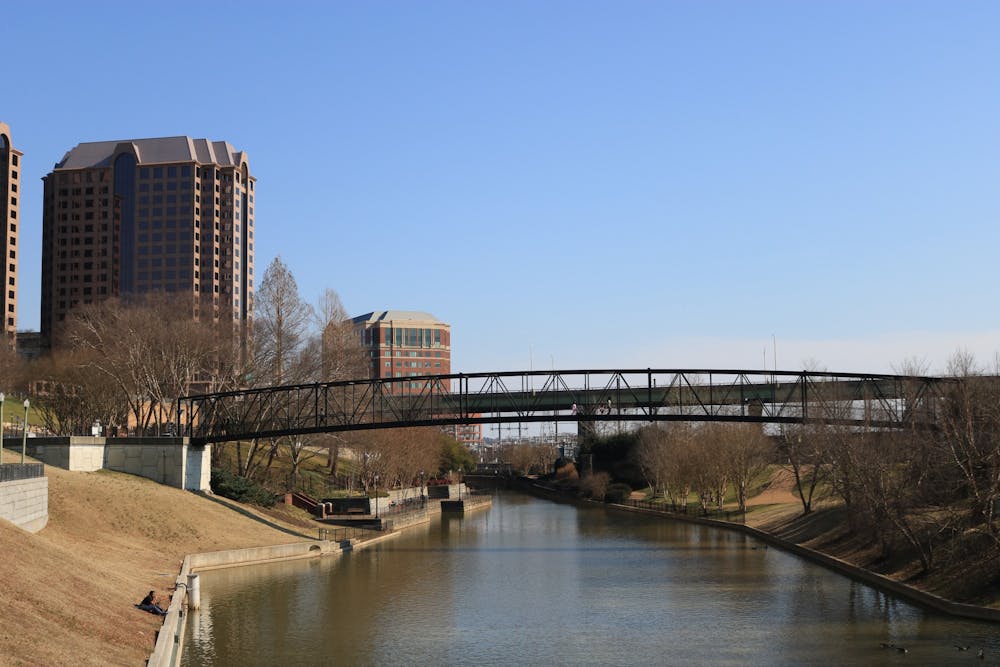The James River Association released its latest report in October on the state of Richmond’s historically troubled waterway, with its score remaining at a low B.
The range for a B ranking is 60% to 79% based on indicators related to the ecological health of the river. The James River ranked a B in fish and wildlife, habitat, river health, protection and restoration actions, and river restoration efforts. It ranked a B-minus in pollution reductions, averaging out to an overall B according to the report.
The James River has ranked a B score or higher in every biennial report since 2015. The percent ranged from 64% to 66%. Prior to 2015, the James River was ranked a C grade according to their website.
The health and well-being of local Richmond residents and surrounding areas is affected by the health of the James River.
“The health of the community is dependent on the health of the environment we live in,” Stephen Rast, a Brookland District Board of Supervisors candidate this year, wrote in an email to The Collegian. “A polluted James River leads to a polluted water and food supply, where a healthy James River leads to a place where families can grow without fear of getting sick.”
The report is put together using data from associates all across the watershed. It inspects the status and trends of 18 indicators in River Health and River Restoration Progress.
In the public statement released by the JRA, CEO and President Bill Street said, “While progress has slowed in recent years as the river faces new challenges from climate change, we see signs that a grade A James is possible if we keep up our collective commitment and all do our part to safeguard the river for future generations,” Street said.
Tom Dunlap, the new riverkeeper at the JRA, recognized the need to escalate efforts toward a cleaner river.
“Despite notable advancements, especially in recent years, it is evident from our score that the pace of progress has started to taper,” Dunlap wrote in an email to The Collegian. “Renewed dedication and intensified efforts will be essential to elevate the James River to an A rating.”
The Henrico Water Reclamation Facility has dumped roughly 65 million gallons of raw sewage into the James River over the past five years, Rast wrote.
The water reclamation facility began operations in 1989 and treats sewage from the majority of Henrico County and some parts of Goochland and Hanover counties, according to the Henrico County website. It is a part of the Water Quality Management Plan for the Richmond metropolitan area, acquired by the State Water Control Board on Aug. 26, 1974.
“These failures fall onto local governments, and it’s the community’s responsibility to hold our government accountable,” Rast wrote.
Enjoy what you're reading?
Signup for our newsletter
Paige Wesselink, an employee at The Sierra Club of Virginia, a non-partisan advocacy organization, said the local government needs to take this matter seriously and make a change to better the community.
In a Richmond Times-Dispatch news report released Oct. 27 it stated, “bacteria from livestock, pet and human wastes still pose health risks along much of the James, with only 61% of testing sites meeting state standards. The association says more livestock fencing and regular inspections of septic systems are key to tackling this problem.”
Wesselink believes it comes down to decision-makers.
“When we have more stringent laws and policies around how we treat our water when we're putting it back into the river, that's what's going to make the biggest difference in the water quality itself,” Wesselink said.
Another large contributor to the pollution in the James River is the old sewers in the city of Richmond and surrounding areas, Rast wrote.
On Sept. 6, NBC 12 reported that proposals to add $100 million in state funds dedicated to improving Richmond’s combined sewer overflow system were denied. The report also said Richmond needs about $1 billion to complete a project to update the city’s 100-year-old sewer system.
State law requires the city to separate its sewage systems and stormwater by 2035.
Rainwater and sanitary sewage have very different kinds of pollutants that must be treated, Rast wrote.
“Mixing both into a single pipe system means all water across the city is required to be cleaned more than necessary to properly follow regulations,” Rast wrote. “Because our water reclamation plant isn’t suited to treat all kinds of pollutants for all water at once, the plant often gets overwhelmed and just dumps excess water straight into the river with no treatment. The best way to solve this problem is to separate out the rainwater sewer from the sanitary sewer.”
The health of the community is dependent on the James River, said Rast.
“The James River serves as a vital source of drinking water for over 2.7 million residents, while also contributing meaningfully to the seafood supply, yielding over 4 million pounds of fish and shellfish in 2022,” Dunlap wrote. “Additionally, the river offers exceptional recreational opportunities for both locals and tourists.”
The students and community members who spoke to The Collegian agreed.
“I really enjoy a body of water,” UR senior Lily VonSpreckelsen said. “Especially because I grew up in New York City it was not as easily accessible for me, so having the James River has been really nice.”
VonSpreckelsen said that she goes to the James River multiple times a week when the weather is in the 70s or higher.
“Normally I go find a nice rock in the sun out on the water and just lay there,” VonSpreckelsen said. “I will go with a friend, maybe bring a book. If the water looks clean enough or if it’s warm enough I’ll go in the water and swim a little bit.”
Dani Valderrama, senior at UR said she mainly goes to the river to run on the trails surrounding it, but has swum a couple of times.
“The James River is important to me because it is an escape from the mundane university campus bubble,” Valderrama said. “With just a ten-minute run I can get to nature and relieve stress.”
Her observation is supported by science. According to a study published by PLOS ONE in 2022, spending time near rivers or canals is beneficial to your mental health and well-being.
“These findings have potential implications for mental health as well as urban planning and policy,” the article wrote. “Visits to canals and rivers could become part of social prescribing schemes, playing a role in preventing mental health difficulties and complementing more traditional interventions.”
Wesselink used to be a part of a program in which inner city kids would be taken to the river for the first time, and she and others would canoe them down the rapids, she said.
“It was such a unique and incredible experience for these kids,” Wesselink said. “Just seeing their reactions to seeing the river for the first time and being able to play outside all day was very cool.”
According to the PLOS ONE study, participants were more likely to report feeling socially included when visiting canals and rivers.
“Fundamentally, The James River stands as a cornerstone, providing a means to reestablish a meaningful connection between people and their natural surroundings,” Dunlap wrote.
Contact contributing writer Carly Cohen at carly.cohen@richmond.edu.
Support independent student media
You can make a tax-deductible donation by clicking the button below, which takes you to our secure PayPal account. The page is set up to receive contributions in whatever amount you designate. We look forward to using the money we raise to further our mission of providing honest and accurate information to students, faculty, staff, alumni and others in the general public.
Donate Now



